To boost your social media results, first answer these crucial questions
Did you know that the very first tweet was sent only 11 years ago? It was posted in 2006 by Twitter’s co-creator Jack Dorsey who simply wrote, ‘just setting up my twttr’. It has since received more than 93,000 retweets and over 72,000 likes.
Twitter was by no means the first social media platform - you may remember the likes of MySpace and Bebo. But Twitter was a game changer, evolving not only the way we share information but the way we receive it too.
At this point, it is safe to say that no one knew quite how colossal this industry was going to be, let alone how key it would become to brand marketing campaigns.
You would probably have laughed at the idea of someone spending their working day updating Twitter statuses and editing photos to share, and you might have scoffed at the thought it could actually help to grow your brand.
Today, however, whole teams work across the likes of Facebook, Twitter, Instagram and Snapchat.
Towards the end of 2016, Twitter averaged 317 million monthly active users while Facebook had a whopping 1.79 billion monthly active users; Instagram had reached 500 million. Of course, the rise of mobile has played a part in this. It is now easier than ever before to scroll through our social media feeds and we spend an awful lot of time doing that – 90 minutes a day on average or a collective total of 23 days a year.
Those are big numbers and illustrate the influence social media has on our lives. But despite its growing importance, many companies still struggle to maximise the full potential of these platforms, and truly add value to their overall identity.
Is your business doing social media right? To help answer that, here are 10 critical questions to ask yourself:
1. Why am I using it?
To understand whether you are using it right you need to understand why you should be using it. Firstly, at a basic level, it's essentially free marketing - why wouldn't you use it?
Before you start setting up social media profiles it's important that you work out your goals and objectives and how social media can help you achieve them.
These might include:
- Find new customers
- Engage with existing customers
- Share new products and ideas
- Get instant feedback
- Profile your demographic
- Build links to your website or service
- Improve brand awareness
Then ask yourself, what sort of company do I want to be on social media? Will my profile be serious and just related to business or will it be a bit more laid back and playful? You should keep your tweets and posts consistent and this will be easier to achieve when you have the answers to these questions.
Airbnb were one start-up, back in 2008, who instantly took full advantage of social media and are now reaping the rewards with millions of users across 192 countries.
They were quick to realise that each person using their company for accommodation would start up a conversation on social networking sites as soon as their holiday began. Then, their own presence on there would enable them to be part of this too. By taking this approach and engaging with clients on Twitter and Facebook they were able to create a rapidly loyal community.
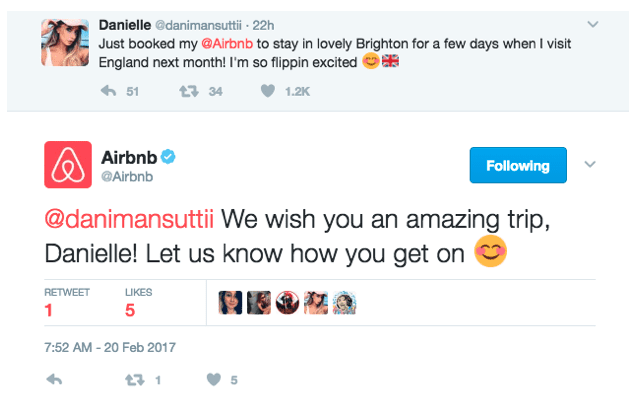
With large volumes of interactions to keep track of, the travel rentals company use Hootsuite’s social media management system to manage thousands of conversations across the globe. They use analytics to monitor follower growth and social CRM (customer relationship management) while tracking keywords enables the company to create their social campaigns accordingly.f
2. Have I got the basics right?
You need to work out which social accounts will work best for you. There is no point spending the majority of your time on Facebook if your customers are primarily on Twitter or vice versa.
Instagram – If you don't have great images to share then don't bother with this platform. If you do, make sure you take advantage of hashtags to get them in front of the right eyes.
Twitter - This platform enables you to share quick bites of information and photos - but you need to make sure that it is enticing enough to not only stop the user scrolling but also to then click through.
Facebook - This is a personal network we tend to primarily use to connect with friends and family. If you are going to use this platform it is important to keep this in mind - simply pushing your product on the user will quickly have them clicking on the ‘unlike’ button.
Snapchat - This growing platform is perfect for giving potential customers a sneak peek behind the scenes. Just make sure you have something interesting to show them.
Once you have set your platforms up, you need to make sure you are using them in the right way.
A couple of dos and don’ts:
Do: post regularly
Don't: be too serious or dull
Do: always keep your audience in mind
Don't: become a spammer!
Do: look into the best times to be posting on different platforms
Don't: forget about hashtags and make sure you are using them in the right way
Do: share more than just a title and link to your content or product
Don't: be rude or offensive
Do: create a social strategy
Don’t: underestimate the importance of tone of voice
Do: be original and creative with your posts
Don’t: forget to engage with your followers
Do: humanize your brand by showing personality
Don’t: delete negative comments – it is always better to address them.
Do: monitor your platforms and use feedback to make relevant changes
3. Do I understand the power of a creative post?
There are many brands who have social media nailed. They have an incredibly effective social media strategy but also know that the nature of such platforms - primarily the fact that it is instant - means they can take advantage of it in a way that they have never been able to do before.
Oreo are one of the best examples of this. During a blackout at the Super Bowl in 2013, they seized the opportunity to tweet that ‘you can still dunk in the dark.'
So simple yet so effective. One hour and 10,000 retweets later, Oreo were receiving a better pay-off from their quick thinking than their official Super Bowl ad which cost millions to create.
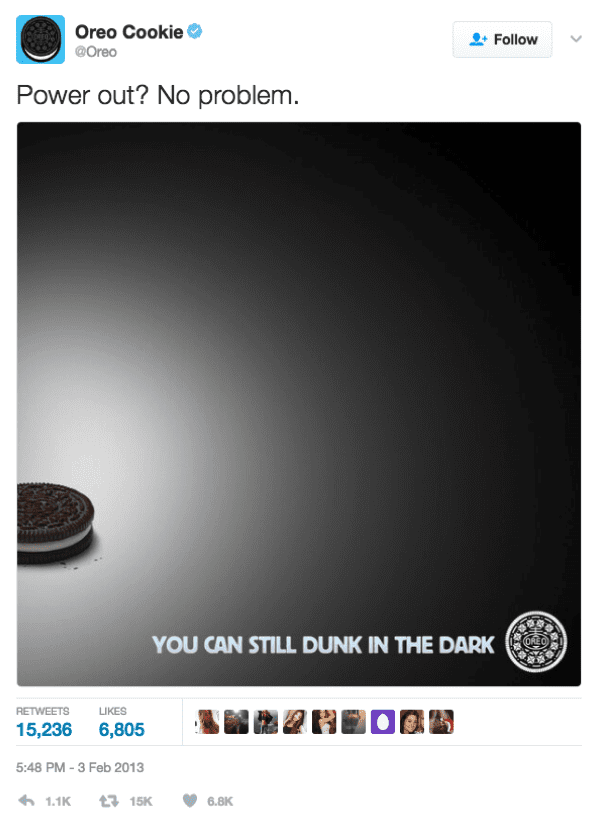
Successful companies also take advantage of the fact they can talk to their customers - sometimes to thank them for their kind tweets, other times to try and rectify an issue and occasionally, like Sainsbury's, to embark on a puntastic conversation…
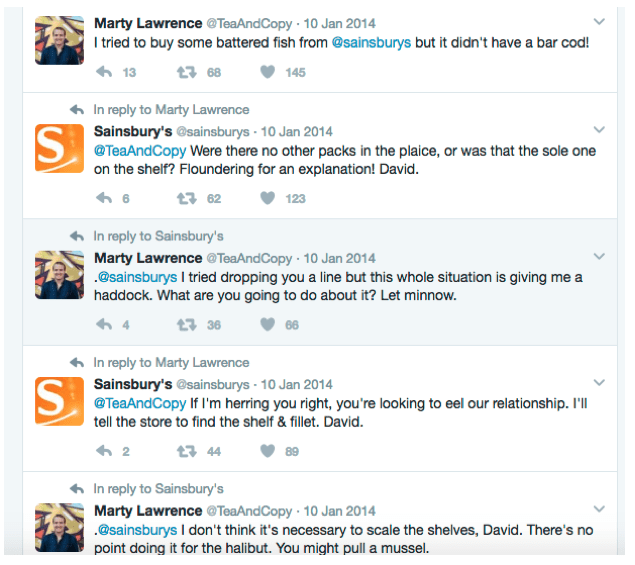
It finally came to a close …
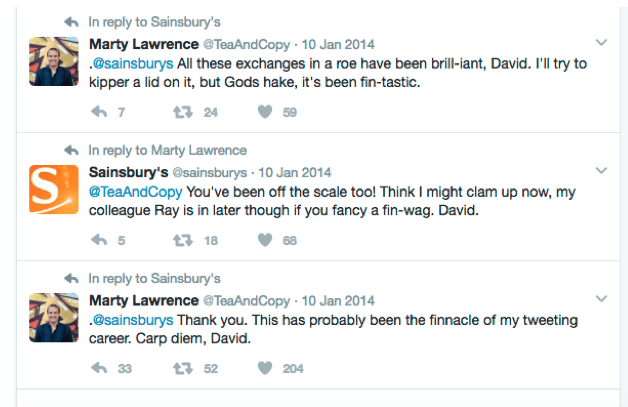
Was it a PR stunt? Perhaps. Does it matter? No, not really. Whether they saw an opportunity and went with it or had it planned all along, it worked. It got people talking about them, and ultimately, that is so often the goal with social media.
Others who are using social media successfully know that it is not all about quick wins - it won't change things for you overnight.
Take Innocent, for example. Ultimately they want you to buy smoothies, but it is their funny, quirky and clever tone of voice - apparent across all their channels - that encourages you to not only follow them but share and interact with their content too.
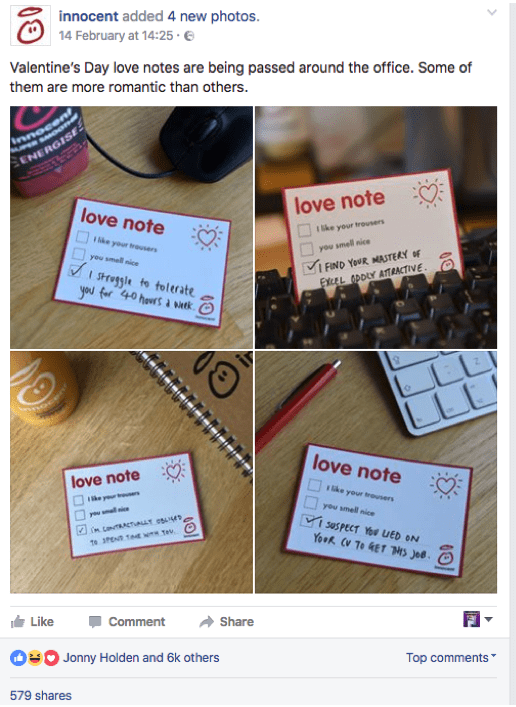
Their Valentine’s Day tweet wasn’t related to smoothies but it was shareable and branded, which helps to increase awareness and a loyal following.
Similarly, the aim of ASOS, who have 17 million followers across social channels and have won countless awards for social strategies, is to persuade you to purchase the clothes, shoes and accessories on their website.
In order to do this, they know they need to produce current and up-to-date content and social that goes beyond just the products they sell so that people will engage with it – building a following which will ultimately increase traffic and therefore sales. And they do this really, really well. Take a look at this post to see how they use their various platforms for slightly differing purposes.
Over on Instagram ASOS encourage people to share images of their outfits with the hashtag #asseenonme - currently, there are 382,657 posts with this hashtag. They also work with digital influencers who have large numbers of followers who already look to them for influence and advice. But brand awareness doesn’t just come from the actual clothing being shared, it could be as simple as an image that features a cute cat in an ASOS box…
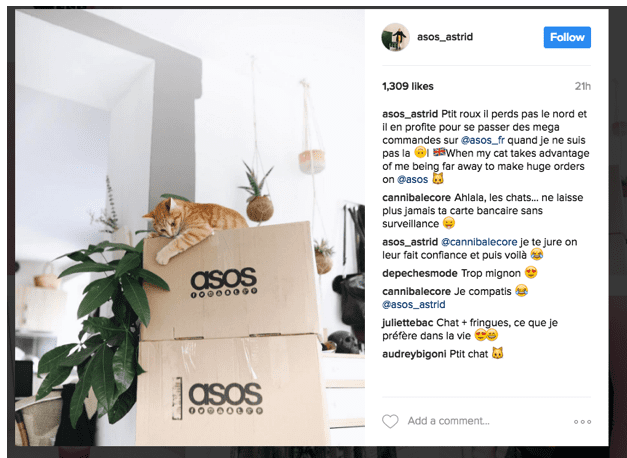
Effectively your customers are doing the marketing for you – it is essentially ‘word of mouth’ but online, for millions of people to see simultaneously.
I recently interviewed Sedge Beswick (which you can read here). Sedge was Global Social and Community Manager at ASOS for over four years.
She told me: “My one bug bear is with brands that only think about themselves.
For example, 'we want to sell more units of this orange dress.' They then share the same picture with a broadcast message across all their owned social feeds. The way people behave and use each of the platforms is different… it’s not about you. All businesses should have a unique strategy for each channel. It’s about quality, not quantity and using the platforms the way your customer uses the platforms.”
4. Am I learning from other brands' mistakes?
At the same time as learning from the brands who are doing it right, you need to learn from the brands who have done it wrong and make sure you don’t make the same mistakes.
While being instant can work to your advantage it can also be a big disadvantage if you get it wrong. Every single tweet you post can have an impact, whether that be positively or negatively. Hashtags can be hijacked, attempts at humour can backfire and misuse can cause outrage.
This David Bowie tribute from British Gas became a contender for the worst tweet of 2017, only 10 days in. It was poorly done for several reasons, including the blasé nature of the message, the use of it for self-promotion, the spelling and grammar mistakes and the use of an incorrect hashtag.
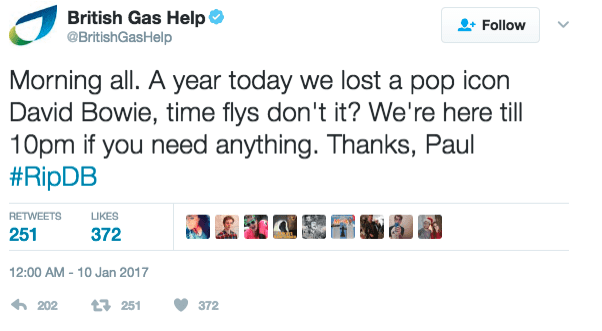
Similarly, the London Dungeon caused Twitter users to post the following comments during their Valentine’s Day social campaign.
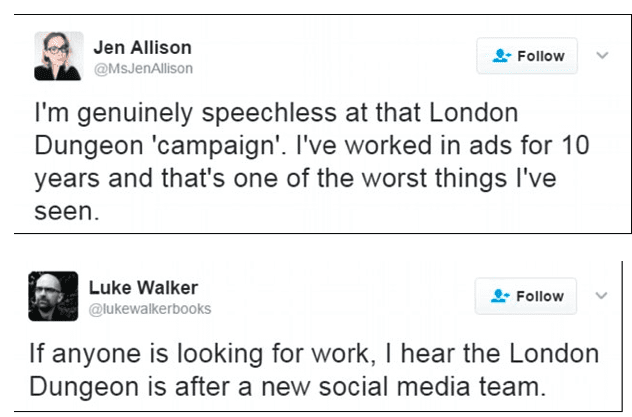
This was the least offensive of their posts…
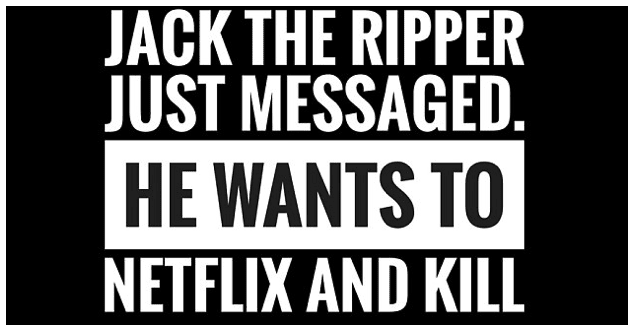
It has since been deleted and an apology posted. Unfortunately for them, it had already been saved, shared and discussed. Such is the nature of social media.
You could argue that there is no such thing as bad publicity, but would you really want millions of people to think of not only the nature of the original messages but the responses to it, each and every time your brand comes to mind?
Take a look at this post by my colleague for more social media success and fails from last year as well as some predictions for this year.
5. Do I know who my audience is?
It is vital you know who your audience is so you aren’t directing your content at the wrong people. It is great to get people engaging with you but if they aren’t your target market then you won't drive traffic or sales.
At Zazzle Media our strategy team use Facebook insights, Comscore and GWI to help build an idea of our clients' audiences – across Facebook and their website. Once you know who you are aiming at, how they use social media and spend their time, you will know what you need to be posting, where and when, to spark their interest.
6. Am I sharing my content in the right way?
Part of building a brand is about creating content that will enable you to build a loyal following of your product's target audience - who won't only buy from you but will engage with you and help to build on that following.
But if that content sits hidden away in the depths of your website, what is the point in writing it? Use the right hashtags, @ the right people, entice them to click through and social media will enable you to get a huge amount of eyes on your written words.
Take a look at this post - where I discuss the stages of content creation including how to share your content, in a bit more detail as well as this one where Zazzle’s Senior Content Editor Andrew Brookes looks at what we content writers can learn from social media.
7. Am I going beyond the bare minimum?
Simply share link after link to your content or product and you may find people pressing that 'unfollow' button. It is imperative that you are building brand awareness, which will boost web traffic and lead to loyal customers. You do not just want to sell to them!
You need to let people know who you are and what your company is all about – what makes you unique and stand out among all the other companies. The best way to do this is to engage and interact to start building an online community.
The beauty of Sainsbury’s funny conversation is that it was there for everyone to see and it gained them some positive PR, simply through engaging with a follower.
You can also run competitions - this is a great way to encourage followers to like, comment on and share your content. You should also post other content your audience may be interested in - pieces they are likely to share.
Images or video tend to work best because they are incredibly shareable. This doesn't have to relate directly to your brand, simply including your logo will build brand awareness.
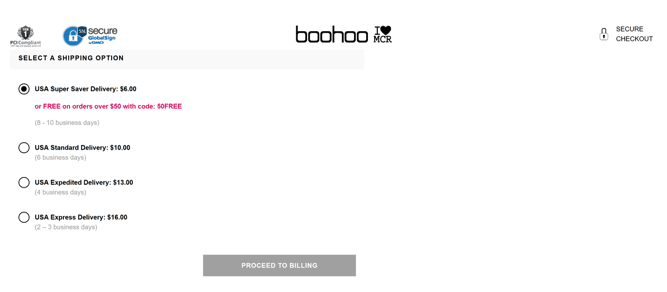
Once you have started to build it up, invest money - promote tweets, work with digital influencers and so on.
8. How does social media fit into my wider marketing strategy?
While many companies are setting aside a percentage of their budget for social media marketing, physical advertising is still important as it can reach areas that online advertising can’t.
Essentially the simplest way to link the two is to direct all your print back to your social media. If you can capture the interest of potential customers and clients through print advertising, they will visit your social media to find out more.
A perfect but simple thing to include on your print adverting is 'Follow us on Twitter', or 'Like us on Facebook.'
A hashtag campaign is always a great way to get people talking and an easy way for you to follow what is being said. Create a long-lasting unique hashtag which can then be used consistently throughout your advertising.
The #LidlSurprises campaign was initially launched to start changing perceptions of the supermarket. They now use the hashtag across all promotions and have even supported their offline campaign by using tweets from customers as in-store advertising.
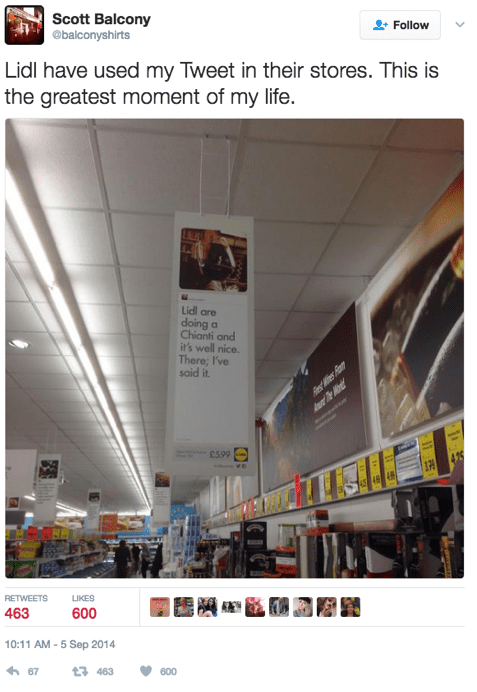
You can also use social media to find out where your target market spends their offline time and what they want, to guide the direction you take your print advertising in as well as who to aim it at.
9. Am I measuring my success?
Don’t just leave your posts to disappear down your timeline – you need to monitor the results. The beauty of these platforms is that they are always offering us new ways to gain insight into the success of our posts. So use this analytics to discover what people are reading, when they are reading it, who is reading it and so on. And, of course, simply keep an eye on your posts - what kind of content is receiving the most shares, likes and comments?
10. Do I understand how social media will change and therefore how to keep up and get ahead?
The world of social media is fast-paced, so you need to keep an eye on how it is changing and ensure you are always changing with it – to not only keep up but actually get ahead of the competition.
For instance, it's only recently that we have been able to share live content on both Facebook and Instagram. This has the unique benefit of allowing the user to be ‘in the moment’ with you and allows them to get information quickly and visually – which is exactly what they want. It is important to acknowledge this and work out how you can incorporate it into your social strategy.
Social media is changing, growing and adapting each and every day - it is hard to know what could happen tomorrow, let alone going forward, but what we do know is that it will continue to offer up new and exciting opportunities for marketing.
Do you feel ready to improve your social media presence? You can use this, Social Card Previewer, which makes sharing content easier than ever before by giving you a snapshot of it in the style of each social networking site.

Thanks to Ellie for sharing her advice and opinions in this post. Ellie is a content editor at digital marketing agency
Zazzle Media, where she writes on a range of topics for leading companies every day. After studying English, Media and Cultural Studies at UWE Bristol she has built up a varied writing career in both journalism and copywriting. In her spare time she writes her own blog and contributes to the Huffington Post. When she's not writing she loves travelling and going to festivals... which she usually ends up writing about afterwards! Follow her on
Twitter to find out more.














 Thanks to Ellie for sharing her advice and opinions in this post. Ellie is a content editor at digital marketing agency
Thanks to Ellie for sharing her advice and opinions in this post. Ellie is a content editor at digital marketing agency 


